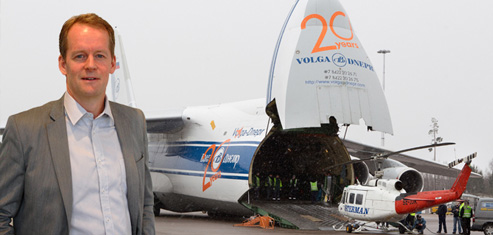President of Nippon Ericsson and Chairman of the Swedish Chamber of Commerce talks to Weekender.
Several months have passed since the devastating earthquake and business is (almost) back to normal in Tokyo. Many companies have helped in the rebuilding of Tohoku, but most work behind the scenes, receiving little praise or media coverage. Nippon Ericsson is one such company, the Swedish telecom giant provided essential communication links for emergency services, going as far as flying their own helicopter to Japan in order to rebuild the damaged cellular network. Weekender sat down with President and Representative Director of Nippon Ericsson K.K. Fredrik Alatalo at Ericsson’s Tokyo headquarters to talk about the challenges he faced.
Where were you on 3/11?
I was on my way to Ericsson’s second office in Shin Yokohama. Like most people, I didn’t realize how bad the situation was at first.
Tell us a bit about what you did afterwards.
We immediately put people close to our customers. We have a few base stations in Tohoku that received structural damage and though we aimed to help our customers (such as Docomo), we ended up helping the public more.
Is the cellular network back to 100%?
This is a tricky question—it is not back to 100%, because if people have left an area, then the question is why bring it back to “normal”. We basically install enough equipment to get coverage. There are still temporary measures in the North, we brought in special ‘mobile’ mobile-equipment. Though in many areas the main problem was a system overload, not actual damage.
We hear you brought in satellite phones – Why did you make that decision?
There was no direct request, but an obvious sign there was a need. In the first days of the disaster, it was clear our customers had a challenge, we lent a few phones and realized—this is a bigger problem. So we decided to bring in an extra 150 phones to help out.
Incredibly you brought a helicopter from Sweden to Japan – What brought that about?
We scouted around locally, but it was very difficult to find one. Headquarters really assisted us. I said ‘things are going well, but we could do with a helicopter,’ At first they were shocked! But they helped a lot. We looked at many alternatives but we decided the fastest way was to fly one in on an Antonov from Sweden.
What did you use the helicopter for?
As well as supplying customers we helped many NGOs. We flew doctors, food and relief goods. We also sent the helicopter to one of the smaller islands off Japan—we were the first people they had seen since the ‘quake.
After the disaster did you consider moving offices, to say Osaka?
Our main customers such as Softbank are in Tokyo, so no. It would be unthinkable to abandon them.
Let’s get personal: How long have you been in Tokyo?
I arrived in October 2007, so nearly four years,
How did you become Chairman of The Swedish Chamber of Commerce and Industry in Japan?
When you arrive in a new country you focus on the basics, after you settle in you have more opportunites to contribute to the community. I first became involved because Ericsson is a member of the chamber, then I got onto the board, and then I got the opportunity to be chairman.
How many Swedish companies are in Japan?
People may know ABB, H&M and Ikea but we have a lot of smaller companies too. There are probably some 200 active Swedish companies in Japan.
Find out more about Nippon Ericsson here: www.ericsson.com/jp
If you would like to be featured in Tokyo Weekender, contact us: editor (at) tokyoweekender.com









